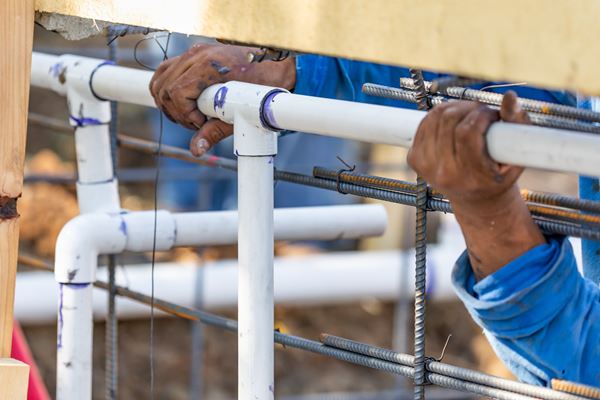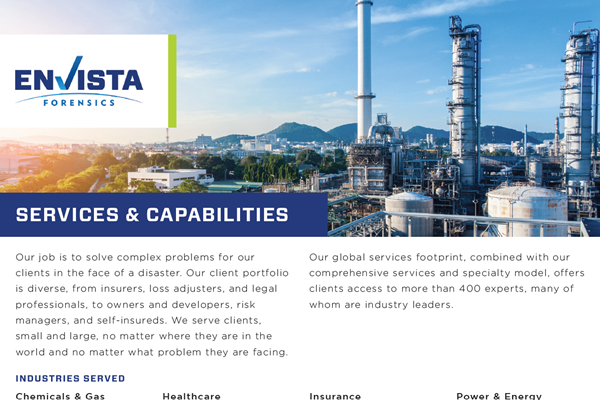Dealing with Field Failure of Plastic Building Products

Plastic is all around us. It’s in the clothes we wear, the electronic devices we use, the vehicles we drive, and even the concrete we walk on. Given the abundance of use, it shouldn’t be surprising that plastics are also used in building products, including pipes and fittings used for potable and process water.
When it comes to the failure of plastic components, especially those carrying water, the resultant damages require the need to identify the exact cause of the failure as the root of the failure will be critical to multiple parties, e.g., the building owner, insurance companies, the manufacturer, and the installer. In any of these cases, there are a number of potential causes that must be considered.
First of all, the material choice likely comes to mind as the most intuitive suspect for the source of the problem. Subsequently if informed that a failed product is made with plastics, the idea of plastics being a lower quality substitute to their metallic counterparts is a common misconception held by the non-technical public, including juries. The fact is, contrary to conventional wisdom, plastics can and might be the right/best candidate for many engineering applications. After all, plastics far outperform metal in a variety of harsh service environments. They are also more lightweight and can be easily manufactured into highly complicated geometries.
Plastics, or technically polymers, are conglomerates of organic chains consisting of large numbers of repeating hydrocarbon subunits; imagine long chains made with ball-and-socket links. Therefore, understandably, the chemical makeup of the subunits (choice of ball-and-socket links), the number of repeating units (length of chain), and the way the chains are packed together (random or ordered) will all influence the observable properties of the resultant polymer chain conglomerates, e.g., mechanical strength, chemical resistance, processing ease, etc. The continued trend of increased use of plastics in many engineering and structural applications is the result of availability of many choices of the repeating unit (versatility) and the abundance of hydrocarbons from petroleum refinery process for raw materials (cost).
To elucidate the richness of plastics and its utility, here are some of the most frequently utilized plastics in building products:
PEX
PEX stands for cross-linked polyethylene. Polyethylene is the simplest hydrocarbon available and consists of just carbon and hydrogen atoms. It is flexible and is normally used for articles such as grocery bags. When cross-links are introduced into the structure, it is equivalent to introducing cross-stitches between straight yarns, and the restriction in movements makes PEX both structurally stronger and more chemically resistant. Over the past two decades, PEX has gained tremendous popularity as a residential water supply piping material. However, the increased use has not come without downsides. When PEX is used in aggressive environments, like supply lines for chlorinated water, negatively charged chloride ions act as an oxidizing agent and can cause degradation of the PE polymer chains. To extend their life, PEX pipes require the addition of antioxidants to help stabilize the PEX material. Continuous exposure to chlorinated water will ultimately lead to degradation of the PEX supply lines until eventual rupture.
PVC/CPVC
PVC/CPVC are the chlorinated version of PE, meaning chlorine atoms are now incorporated onto the main carbon chains to replace some of the hydrogen atoms. With the addition of chlorine atoms on the main chain, it adds stability to the polymer chain due to the extra electrons that chlorine atoms carry. Additionally, the chlorine atoms surrounding the carbon main chains are larger atoms than the hydrogen atoms and therefore offer better protection of the chains from attack. This makes PVC and CPVC excellent choices for sanitary sewer applications and water supply piping, whether buried or above ground. However, in some service environments, problems still do occur.
PVC/CPVC is generally not recommended for use with most solvents (soluble or insoluble) including ketones, ethers, furans, esters, alcohols, and aromatics. The solvents can be absorbed into the CPVC substrate and lead to softening of the CPVC pipe. Cases of CPVC pipes used for fire suppression systems have been reported to fail due to accidental contact with drywall sealant or an anti-freeze agent that contains esters. Polyolester (POE) oils are another contaminant that can result in the degradation of CPVC pipe. While POE oils are not a typical constituent of domestic water supplies, remnants of the oil can sometimes be found within iron pipes or heat exchangers. It has been observed that, even at low levels, POE oil can lead to progressive cracking failures within CPVC pipes (Photograph 1)
Photograph 1: Interior cracking on CPVC joint exposed to POE oil
POM
Polyoxymethylene (POM), also known as acetal, polyacetal, and polyformaldehyde, is an engineering thermoplastic due to its high crystallinity. It is therefore commonly used in precision parts requiring high stiffness, low friction, and excellent dimensional stability, such as supply line nuts and complexly shaped fittings. However, acetal resins are sensitive to acid hydrolysis and oxidation agents such as mineral acid and chlorine. Low levels of chlorine in potable water supplies (1–3 ppm) can be sufficient to cause environmental stress cracking, a problem experienced in both domestic and commercial water supply systems. Refrigerator filters, pipe/tube connectors, and faucet components are also common POM parts that have exhibited ESC due to exposure to chlorinated water.
TPE
Thermoplastic elastomers (TPE), sometimes referred to as thermoplastic rubbers, are a class of copolymers or a physical mix of polymers that consist of materials with both thermoplastic and elastomeric properties. While most elastomers are thermosets (plastics that don’t soften upon heating) and can’t be processed by injection molding, thermoplastic elastomers are relatively easy to manufacture by injection molding and other thermal processing techniques. TPE thus shows advantages typical of both rubbery materials and plastic materials and is frequently used where conventional elastomers cannot provide the range of physical properties needed in the product. Flexible thin-walled tubing and rubber roofing material are a couple of examples.
Field Failure Analysis of Plastics
Now that you have some introduction to commonly used plastic materials for building products under the belt, let’s look at how a field failure is approached next. In the world of failure analysis, when it comes to component failure, regardless of the material, metallic or non-metallic, four relevant factors are to be considered before any verdict can be derived, i.e., material selection, part design, manufacturing processes, and installation errors.
Material selection is without a doubt the number one task when it comes to developing any commercial products. On top of structural integrity requirements, application environment (likelihood of exposure to detrimental chemicals or not), expected life span, and overall cost target are the first level of considerations that will help define the probable material candidates. However, it is not unusual to see cases where cost target overrides the structural integrity and application environment requirements. Certainly, a landmine to watch out for when dealing with field failure cases.
Once the proper material is selected, then comes the part design. Achieving desired structural integrity in a component requires not only inherent material strength but also structural stiffness, which is geometry dependent like wall thickness. On top of wall thickness, sharp corners can cause stress concentration and lead to failure at lower than target nominal applied stress. Consequently, proper radiuses to avoid sharp corners and proper bottom thread design for effective thread engagement are some of the seemingly trivial yet critical factors to look out for in a failed part.
After proper selection of material and appropriate design considerations, plastic parts then get fabricated commonly via injection molding (with 3D geometry) or extrusion (tubing). Not surprisingly, proper fabrication process parameters will also impact the quality and end performance of the components.
Some of the critical processing parameters for injection molding are adequate raw material drying, molding temperatures, injection speed, mold design for efficient material flow path and mold cavity air venting, and lastly cooling speed to minimize residual stress. For extrusion, temperatures for different process zones, proper screw elements configuration for material to be processed, and extrusion speed are some of the important parameters to pay attention to. Localized stress concentration due to air entrapment associated with inadequate raw material drying and/or poor injection mold cavity air venting are regular issues encountered in injection molding. For extrusion, premature material degradation frequently happens due to improper processing temperatures and/or excessive mechanical shearing imposed on the material by incorrect configuration of the screw elements. Therefore, signs of air bubbles, localized defects, and lower-than-projected material properties are always something to keep in mind when processing mistakes are suspected.
Lastly, even if everything associated with producing the parts has been handled correctly, installation errors could wipe out all the good efforts leading up to the final step of the project. Overtightening (over-torquing) is the most common mistake encountered in field failure of plastic parts. Installers who are accustomed to installing metal fittings have the tendency to apply the same rules in connecting plastic fittings, especially if the installation involves a male metal component threaded into a plastic female component. Failure at thread bases of the plastic components is the most observed field occurrence. Another installation error involves accidental unintended exposure of plastic parts to detrimental chemicals. CPVC pipes coming into contact with anti-freeze agent containing polyester or POE oil from heat exchangers are good examples of this category.
So, it is always good practice to consider the four factors before rendering any conclusion. But, sometimes, even after taking into account all of the factors, exceptions can still occur. One good example entails PEX water supply pipes. ASTM (American Society for Testing and Materials) Standard F876 establishes the performance requirements for PEX pipes. PEX manufacturers whose products pass the F876 requirements normally warranty their products for at least 25 years of field life. Yet, periodic chlorine spikes in potable water and local water quality could still lead to premature failure of the PEX supply lines. Photograph 2 and Photograph 3 show a PEX pipe degrading over time in a chlorinated water environment. One can see the initiation and propagation of longitudinal cracks due to environmental stress cracking. The hydrostatic water pressure intermittently applied on the pipe, coupled with the chlorine attack, has then caused the inner surface to develop surface and through-thickness propagating longitudinal cracks on the pipe. The sad reality is the pipe has been in the field for less than 10 years.
Photograph 2 - Longitudinal cracks on inner surface of PEX pipe
Photograph 3 – Opened longitudinal cracks
Finally, to sum it all up, failures of building products, plastics or not, contribute to billions of dollars in losses every year. Even though something like a failed pipe causing a water leak may seem like a simple investigation on the surface, the actual underlying cause of the failure may be complex and involve many contributing causal factors. Therefore, it is important for you to have the right forensic experts on your team with the right testing capabilities to ensure an accurate investigation so you can understand and be able to cover all facets of the failure in your case.
Our experts are ready to help.







